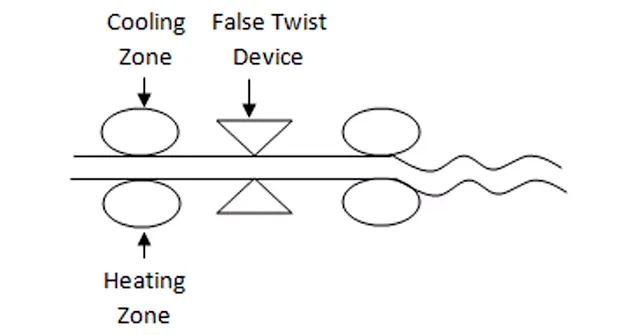Flow Chart of Man-Made Fiber Production
{getToc} $title={Table of Contents}
Manufacture of the Fiber - Forming Polymer
↓
Spinning (Extrusion Through Spinneret)
↓
Drawing / Stretching
↓
Texturizing / Crimping
↓
Intermingling / Interlacing
↓
Heat Setting
↓
Spin Finish and Cutting
Manufacture of the Fiber Forming Polymer
1. All Man-Made Fibers are compounds of long-chain molecules known as polymers, which are formed by chemical processing.
2. Common groups in polymers are-
- Amide or peptide groups (-CO-NH-)
- Benzene ring (C6H6)
- Ether linkage (-C-O-C-)
- Hydroxyl group (-OH)
- Nitrite group (-C-N-)
- Vander wall's force = 8.4 KJ [Bond energy] (Very weak)
- Hydrogen bonds = 20.9 (Weak)
- Salt linkage = 54.5 KJ (Strong)
- Cross-link = 245.3 KJ (Very strong)
- Hydrophilic
- Chemical resistance
- Linear
- Long
- Capable of being oriented
- Able to form a high melting point polymer system.
- Wood pulp
- Petroleum
Spinning (Extrusion Through Spinneret)
1. The conversion of polymer into fiber is called spinning. The fiber-forming substance is made temporarily fluid extended through a spinneret and then returned to a solid phase (by solidification into fiber)
2. Four types of SPG process
- Melt SPG
- Wet SPG
- Dry SPG
- Electro SPG (To produce nanofiber ) {1 nm = 1/109m}
- A nozzle or plate provided with five holes or slits through fiber manufacturing is called a spinneret.
- It is the most important part of Man-Made Fiber production.
- The number of holes, sizes, and shapes varies with the cross-section of the filaments desired.
- Round (౦)
- Triangle (△)
- Te (T)
- Cross (×)
- Star (☆
- Oval (0)
Figure of Spinneret
 |
| Spinneret for MMF Production |
Drawing / Stretching
 |
| Drawing for MMF Production |
1. Improve the strength and crystallinity of Man-Made Fiber.
2. The drawing process of fiber involves passing the filament (To assembles of twist force filaments) over a series of rollers.
3. The rollers at specified constant angular velocities are each faster than the previous one.
4. Commercially, Loy (low), Moy (medium), Poy Partially), Hoy (high), and Foy (fully)- An oriented yarn.
5. In cross strength and orientation, to decrease elongation at break.
6. This may be done while the polymer is still solidifying, or after it has completely cooled.
Texturizing / Crimping
 |
| Texturing for MMF Production |
1. Developing natural fiber properties.
2. To create a bulky structure.
3. The process of introducing crimp loops and coils to continuous filament yarn is known as texturizing.
4. To reduce the transparency, slipperiness, and the possibility of pilling.
5. Texturizing process makes filament yarns more opaque, improves, appearance, and textures improve warmth and absorbency.
6. Softness, fullness, high degree of elasticity, thermal insulation, and moist transparency.
 |
| Crimp Effect on MMF Production |
Intermingling / Interlacing
1. Applied instead of twisting.
2. It is a process of imparting inner filament cohesion by entwining (Tie together), instead of twisting.
3. The entwining is achieved by passing the filaments under light tension through the turbulent zone of an intermingling Jet (nozzle).
4. Ways of intermingling:
- Spot welding: Heat treatment
- Airjet: Air (compressed) at high pressure.
Heat Setting
1. It is a process of imparting dimensional stability to fibers or yarns with successive heating and cooling in dry and moist conditions.
2. The fiber is heated to its glass transition temperature (Tg) Tm > Tg.
3. At this temperature, lateral bonds within the fiber are disturbed, and the polymer chains can shift their positions.
4. The fiber/yarn/fabric is kept under tension until it is cooled, to lock the shapes into the fiber molecular structure.
5. After cooling, the fiber/yarn/ fabric will be stable to any heat lower than that at which it was set.
Objectives
- To impart dimensional stability.
- To reduce shrinkage.
Spin Finish and Cutting
1. The spin finish is the lubricant that provides surface lubricating, plasticizing, and static protection of Man-Made Fiber.
2. It is applied to the yarn in fluid form just before winding.
3. To control friction.
4. Cutting according to requirements (4-20 cm) for staple form.
Tags
Synthetic Fibers